
Clermont is a city in Fayette County, Iowa, United States. The population was 586 at the 2020 census. Clermont is home to Montauk, the mansion of former Iowa governor William Larrabee, along with much historic architecture. Scenes for the movie The Straight Story were filmed here.

Bridge of Allan, also known colloquially as Bofa, is a former spa town in the Stirling council area in Scotland, just north of the city of Stirling.

David Bremner Henderson was an American attorney, Civil War veteran and Republican Party politician who served as the 34th Speaker of the United States House of Representatives from 1899 to 1903. He represented Iowa in the House from 1883 to 1903. He was the first Speaker from west of the Mississippi River, the second foreign-born Speaker, the only Speaker from Iowa, and the last Speaker who was a veteran of the Civil War.

The Church of Our Saviour is a historic Carpenter Gothic Episcopal church located at 2979 Coloma Street, in Placerville, El Dorado County, California, in the United States. The church is part of the Episcopal Diocese of Northern California. On November 17, 1977, it was listed in the National Register of Historic Places as the Episcopal Church of Our Saviour.

S. Stephen's Church is an historic Episcopal church located at 114 George Street in the College Hill neighborhood of Providence, Rhode Island. It is in the Brown University campus and is an active parish in the Episcopal Diocese of Rhode Island.
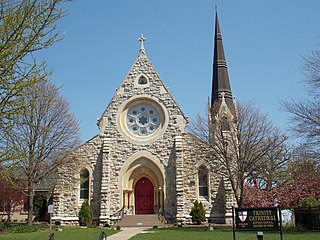
Trinity Episcopal Cathedral, formerly known as Grace Cathedral, is the historic cathedral in the Diocese of Iowa. The cathedral is located on the bluff overlooking Downtown Davenport, Iowa, United States. Completed in 1873, Trinity is one of the oldest cathedrals in the Episcopal Church in the United States. It was individually listed on the National Register of Historic Places in 1974. In 1983 the cathedral was included as a contributing property in the College Square Historic District, which is also listed on the National Register.

Saints Peter and Paul Catholic Church is a former parish church of the Diocese of Davenport. The church is located in rural Solon, Iowa, United States. The property is on a gravel road east of Iowa Highway 1 between Solon and Mount Vernon in rural Johnson County. It was listed on the National Register of Historic Places in 1999.

The Church of Our Saviour is a historic Episcopal parish in the village of Mechanicsburg, Ohio, United States. Founded in the 1890s, it is one of the youngest congregations in the village, but its Gothic Revival-style church building that was constructed soon after the parish's creation has been named a historic site.

St. Patrick's Catholic Church is a parish of the Diocese of Davenport. The church is located in rural Monroe County, Iowa, United States, on U.S. Highway 34, west of Albia, Iowa. It is located in an unincorporated area known as Georgetown and is listed on the National Register of Historic Places.

St. Barnabas Episcopal Church is a former church building in the Episcopal Diocese of Iowa in Montrose, Iowa, United States. It was listed on the National Register of Historic Places in 1986. The building is now called St. Barnabas Wedding Chapel.
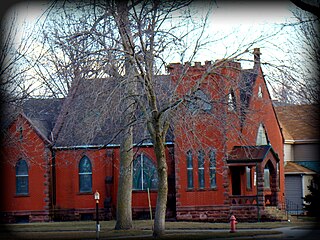
Trinity Memorial Episcopal Church is a former parish church in the Episcopal Diocese of Iowa. The historic building is located in Mapleton, Iowa, United States. It was listed on the National Register of Historic Places in 1990. The former church building and hall now house the Museum of American History.

Union Sunday School is an historic building located in Clermont, Iowa, United States. It was built in 1858 and listed on the National Register of Historic Places in 1974.
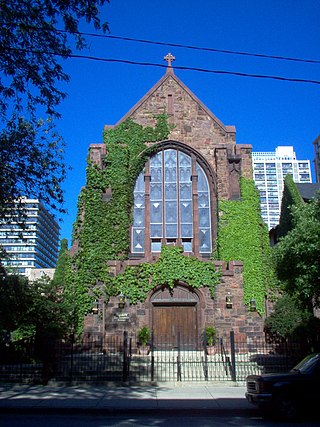
The Episcopal Church of the Atonement and Parish House is a historic church building at 5751 North Kenmore Avenue in Chicago, Illinois. The Gothic Revival building was constructed in 1889 and added to the National Register of Historic Places in 2009.
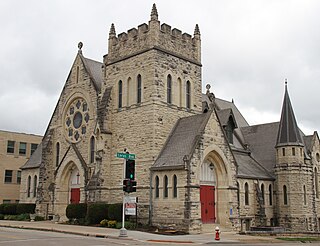
St. John's Episcopal Church is a parish of the Diocese of Iowa, located in Dubuque, Iowa, United States. The church was included as a contributing property in the Jackson Park Historic District that was listed on the National Register of Historic Places in 1986.

The All Saints Episcopal Church in Denver, Colorado, later known as Chapel of Our Merciful Saviour, is a historic church at 2222 W. 32nd Avenue. It was built in 1890 and was added to the National Register of Historic Places in 1978.
Howard Hoppin was an American architect from Providence, Rhode Island.
Christ Episcopal Church, or simply Christ Church, is an historic church building located in Burlington, Iowa, United States. It is a part of the Episcopal Diocese of Iowa, and is a contributing property in the Heritage Hill Historic District listed on the National Register of Historic Places.
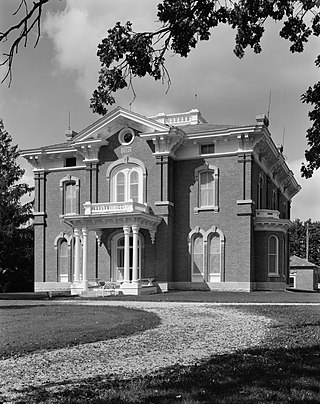
Montauk, also known as Montauk State Preserve, is a historic building located northeast of Clermont, Iowa, United States. It was listed on the National Register of Historic Places in 1973.

Clermont Public School, also known as Larrabee School, is a historic building located in Clermont, Iowa, United States. The school was named for its patron, William Larrabee, who was the twelfth Governor of Iowa. Larrabee himself had been a teacher in Allamakee County, Iowa. During his time in the Iowa Senate and as governor he championed education reform. He used as one of his campaign slogans: "A schoolhouse on every hill and no saloons in the valley." Larrabee and his wife Anna studied school buildings for a number of years, and were involved in planning this building. They hired Cedar Rapids, Iowa architect Charles A. Dieman to design the structure. R. A. Wallace, a contractor from Cedar Rapids, was responsible for its construction. The building was over-engineered as Larrabee insisted that the strength of everything be doubled. The bricks were produced, and the limestone was quarried, locally. It is a two-story Neoclassical building that features a classical portico, brick pilasters with Doric capitals, and two arched dormers on the hipped roof.

Anna Matilda Larrabee was an American social leader. Married to Iowa Governor William Larrabee, she served as the First Lady of Iowa from 1886 until 1890. She was often referred to as "Iowa's Ideal Mother".























